Shows of the Month: Top Exhibition Picks in Paris this February
Suzanne Valadon, Vénus, The Beauty You Beheld, and more. Six shows highlighting female artists, themes of feminine agency, and the Kosovar artistic community.
Olga de Amaral
Currently on display at the Fondation Cartier | Jan 15 - March 16

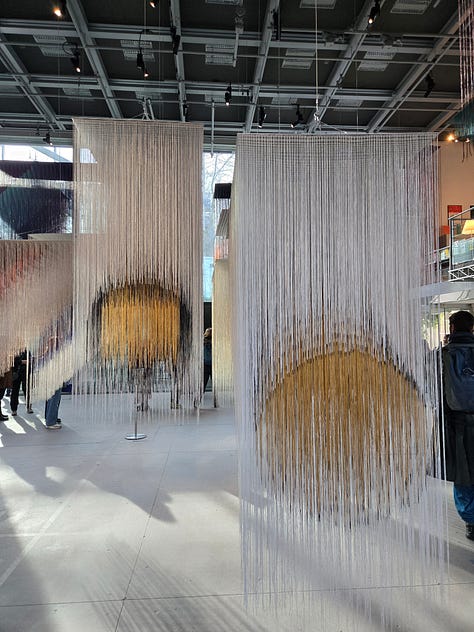

At the Fondation Cartier, the sprawling exhibition space has been transformed into an ethereal Colombian landscape. The ground floor, featuring large-scale tapestries and suspended clouds of color, is interspersed with mineral boulders. Light floods in through the collosal windows, rippling across the multicolored surfaces. On the lower floor, however, the gallery is dimly lit; the emphasis is on the interplay between shadow and light, allowing the eyes to adjust to the gilded, shimmering works. Both levels of the exhibition inspire a harmonious dialogue between illumination and material. The works likewise shape the space and guide visitors through.
The atmosphere in this exhibition is evocative of Olga de Amaral’s prolific presence in the Colombian art scene, and her close-knit relationship to her culture and heritage. Originally from Bogotá, de Amaral is renowned as a pioneer of the 1960s Fiber Art movement, which explored the intersection of art and craft. It was at the Cranbrook Academy of Arts where de Amaral formally studied the distinction between artist and artisan, and discovered her passion for textile design and weaving. Drawing from Modernist principles and folkloric Bauhaus practices, she has experimented with materials and method: weaving, braiding, and knotting with linen, wool, plastic, and more. Her works — infused with mysticism, geometry, and spirituality — liberate textiles beyond decorative use. Take a look up close: intricacies reveal themselves in the structure and composition of her mixed-material works. Keep an eye out for veiled symbols of life and creation (Hint: her gilding evokes the altars of Bogotá’s Catholic churches!).
As her art is rarely shown in Europe, this is an exclusive opportunity to discover eighty of de Amaral’s works (ranging from the 1960s to present day). For those tired of the grey weather and in pursuit of light, this retrospective promises to transport visitors to a realm of interwoven whimsy.
Suzanne Valadon
Currently on display at the Centre Pompidou | Oct 12 - May 26

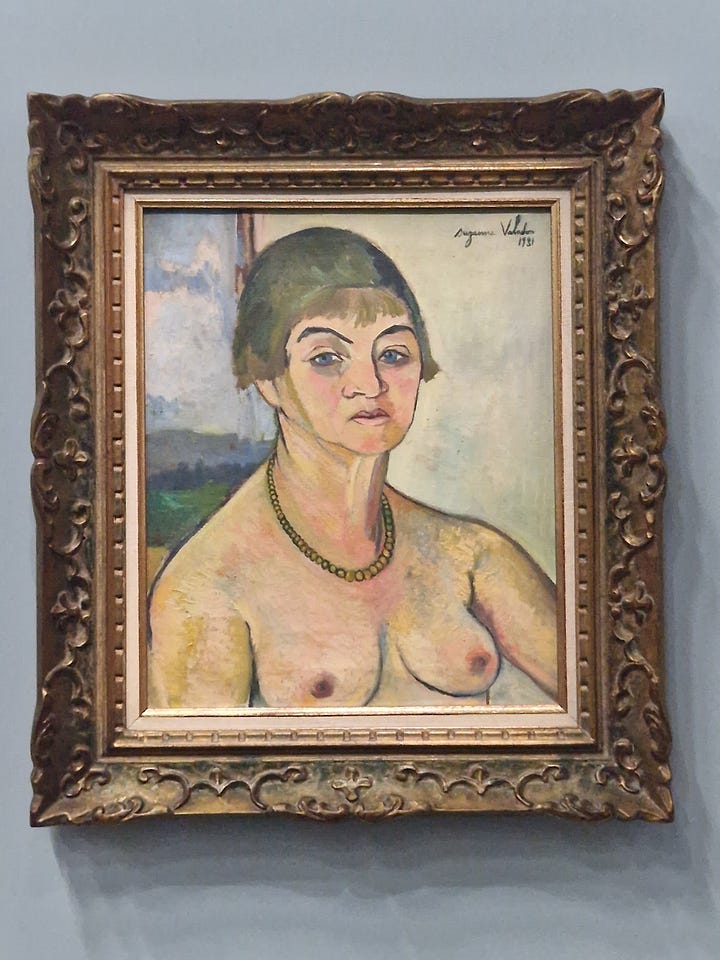
Suzanne Valadon started her career at age 14 as a model, posing for notable artists like Renoir and Toulouse-Lautrec. She was soon thereafter noticed by Degas, who immediately recognized her innate artistic talent and unique painterly hand. Having passed through the studios of many significant male artists, Valadon picked up a myriad of stylistic elements which rendered her works a unique amalgamation of the period’s aesthetic tastes. Degas’ influence is felt in the distinctive stances of her figures, and there is a Renoir-like inventiveness in her color schemes — all while an Impressionist undercurrent runs throughout the scenes she depicts. During the turn of the century, Valadon broke conventions by painting male nudes unabashedly and female nudes in an unidealized, realistic manner — one of the first female artists of her time to do so. She also painted family portraits, Parisian landscapes, and portrayals of the modern woman. The Centre Pompidou will be closing its doors this spring for renovations, with its reopening scheduled for 2030. This exhibition, not to be missed before the cultural hub closes its doors, is the perfect tribute both to Suzanne Valadon’s career and the Pompidou’s curatorial legacy.
“Quels que soient la dureté des temps, les déboires subis, il faut peindre dans la verité, avec amour.”
“Whatever the hardness of the times, the failures suffered, you have to paint truthfully, with love.”
— Suzanne Valadon, Interview with Huguette Garnier (1922)
Carmen Belean: Ballads of Water and Earth
Currently on display at Adrian Sutton Gallery | Feb 8 - March 1
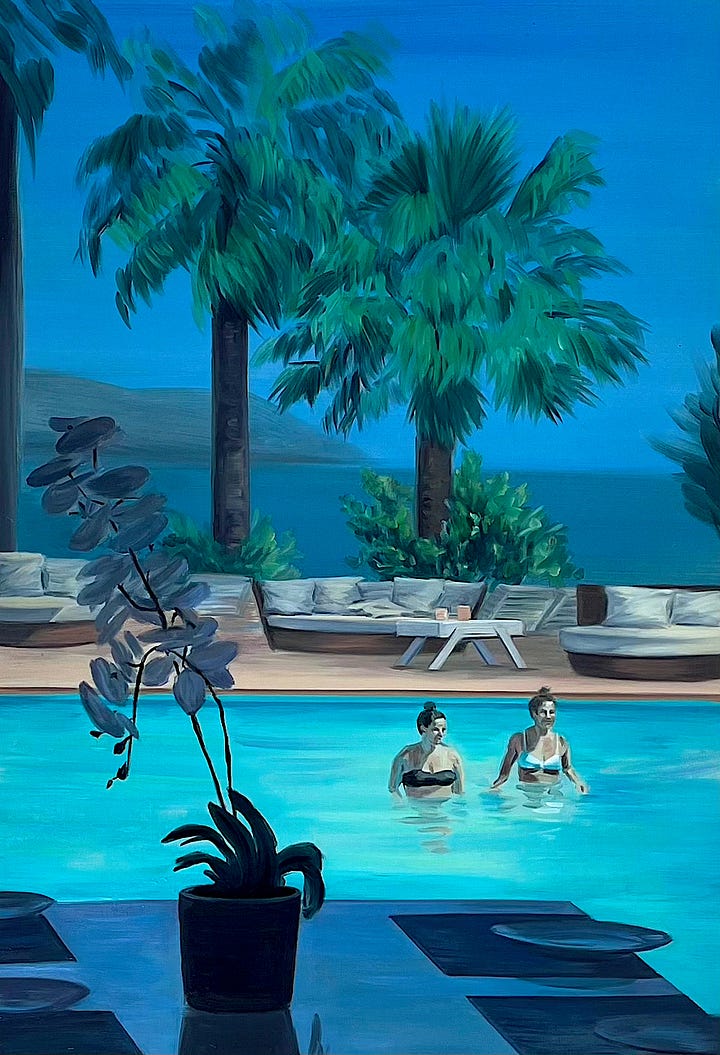

Nestled in the gallery-lined streets of Le Marais, Carmen Belean’s current solo exhibition at Adrian Sutton Gallery provides a welcome taste of warmer days. Belean, a Romanian artist with an eye for idyllic landscapes, brings her vivid paintings and watercolors to the space. Her large-scale tableaus are awash with glowing aquamarine tones, and are inspired by photographic studies of Greek beachside resorts — in particular, the coastal suburbs of Athens. This sliver of paradise provides a sanctuary for sojourners, a quality which Belean effortlessly captures. Reminiscent of David Hockney’s placid vistas or Salomón Huerta’s swimming pools, her paintings go a step further: companionship replaces solitude, and a convivial atmosphere pervades the cheery summer scenes.
In conversation with gallery director Mathilde Le Coz, I reflected upon how women are traditionally depicted in “bathing scenes”. Think Corot’s Diana Surprised at Her Bath (1836) — the element of eroticism and invasion of privacy is ever-present in many such works by male artists. Belean reclaims the gendered associations of bathing in art history, however, and creates a space of feminine liberation. The women in her tableaus bathe for their own recreation, without erotic nuances or the male gaze. Sexualization is stripped away, leaving a paradisiacal space where the bathers can exist in peaceful harmony. These utopic snapshots are as calming as they are empowering. For a mini-escape from the cold February temperatures in Paris, head to Adrian Sutton Gallery — you’ll feel like you’re in Greece!
Prune Nourry: Vénus
Currently on display at Templon | Jan 11 - March 1
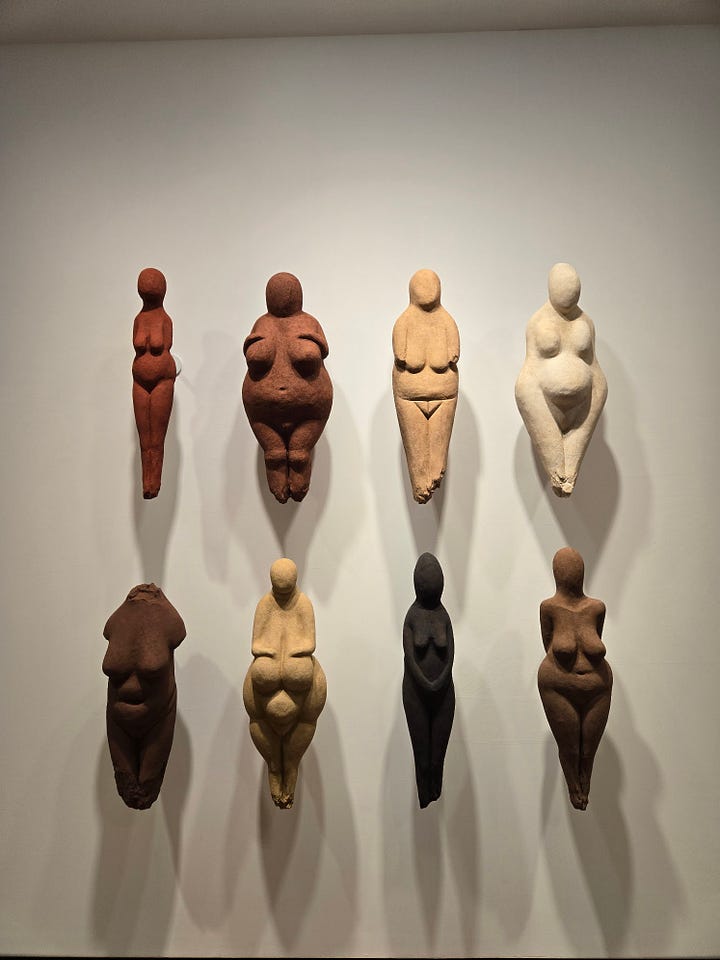
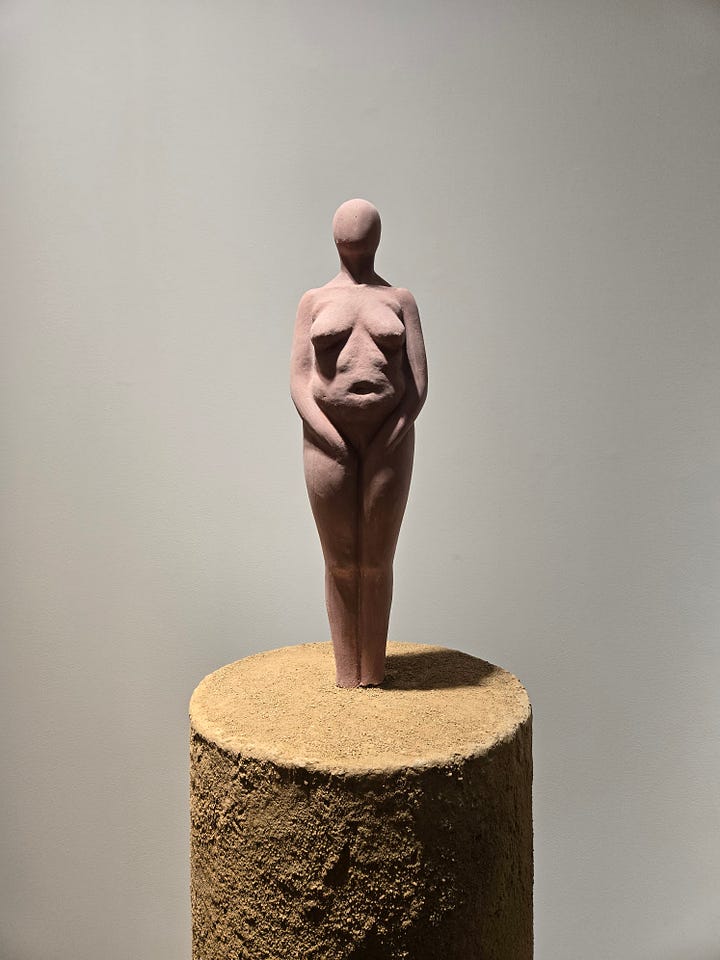
The female body is a testament to its own resilience. It carries children and trauma, stretching to hold space for love. Prune Nourry, a French multidisciplinary artist whose practice is centered around creation myths and earth matter, decided to immortalize the beautiful diversity of the feminine form through Venus. In partnership with Parisian gynecologist Ghada Hatem, Nourry met with eight women at the Maison des Femmes in Saint-Denis (a safe space for victims of violence). The models posed nude for Nourry, allowing her to sculpt their true-to-life portraits using bronze, clay, and terracotta. The act of posing nude was a means for these women to overcoming cultural, personal, and societal taboos — a pathway towards reclaiming agency over their trauma. Modeled after prehistoric Venuses, each figurine (ranging from 12 inches to human-size) is unique to the women whose body it represents. Venus at Templon is a moving exhibition in celebration of womanhood, liberation, and healing.
Fiza Khatri: The Beauty You Beheld
Currently on display at Semiose Galerie | Jan 11 - March 15


With the promise of spring after the frigid Parisian winter, I find myself anticipating the first blossoms with bated breath. In the absence of flowers this February, however, I contented myself with a visit to The Beauty You Beheld — an exhibition as floral-centered as it is intriguing.
When entering Semiose Galerie, the pastel earth tones of Fiza Khatri’s large tableaus render the space soothing and inviting. There is a philosophical element which likewise emerges upon further contemplation of the works: the human-centered tendencies of art history are put into question. That is to say, we are accustomed to humans being the focal points of paintings, while it is largely just still lifes and landscapes which place emphasis on the flowers and the fruits themselves. Khatri, a Pakistani artist who focuses on feminist and queer space-making, has decided to reverse this hierarchy. Her paintings, animated by visible brushstrokes, place humans in the background and bring the flora to the foreground. Her subjects are in a resting state, and their tranquil passivity shifts the attention towards her leafy, verdant greenery.
During my visit, gallery director Benoît Porcher explained that Khatri has presented her work widely, from the UK to Tribeca to the UAE. Further, her participation in art fairs like Art Basel Hong Hong and Art Dubai quickly popularized her distinctive style. Themes of growth, decay, and liberation bloom from the canvases, providing a welcome escape to greener vistas. Stop by Semiose, and don’t miss out on this one-of-a-kind show.
Silent Threads - Resounding Kosova
Currently on display at Galleria Continua | Jan 24 - March 19


When Petrit Halilaj was commissioned to create a site-specific installation on the Metropolitan Museum’s rooftop garden, he created ABETARE (2024) in honor of his Kosovan heritage. The work was a reference to his former elementary school, which was slated for demolition in the village of Runik. Halilaj sought to immortalize the student desk graffiti, and simultaneously honor the recent post-war trauma echoing throughout Kosovo. The country’s turbulent history, scarred by warfare and genocide, has brought forth a generation of artists who take great pride in their culture and roots. There is a palpable determination to preserve the traditions for which they valiantly fought for — and this tenacity resonates throughout the Kosovar artistic community.
On February 17th, Kosovo celebrated its 17th Independence Day. I thought it fitting to pay a visit to Silent Threads - Resounding Kosova at Galleria Continua. The exhibition is curated by Kosovar artist Sislej Xhafa, who brought together fifteen emerging contemporary artists from Kosovo. This generation of post-war creatives has been shaped by their sociopolitical experiences, yet a youthful vibrancy emanates from the works presented. It is a bittersweet triumph over past tragedies — rife with imaginative themes, unexpected elements, and commemorative symbolism. It’s refreshing to see Kosovar artists receiving exposure in international gallery spaces, and I hope gallery-goers will seize this opportunity to engage in an important dialogue surrounding underrepresented ethnic groups. Happy Independence Day, Kosovo!




loveee these recs!